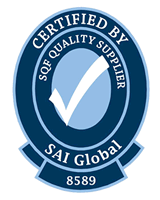A lot of things came together at once to cause these shipping problems. Can smart packaging decisions help you navigate these rough waters?
You’ve no doubt seen the news about supply chain interruptions—and maybe you’re even
experiencing the fallout yourself. A recent article by Craig Fuller on Freightwaves.com examines
some reasons why that is happening and what (if anything) we can do about it.
He points out that all kinds of factors (weather, capacity, labor, policy changes—even terrorism)
have impacted the supply chain over the years. So what went wrong now? One answer is that
there is a massive surge in demand that is straining the market’s capacity. The volume of
products flowing is due in large part, Fuller says, on government stimulus payments that
actually did stimulate consumer spending. The United States cycled through lots of inventory at
a time when production was largely shut down due to the pandemic. Now the backlog and
associated delays are hitting us.
Production is now ramping up, especially in China, but that means the amount of cargo is
greatly increased. Every ship available has been filled, but ports aren’t able to handle the
increased volume. Add to that a lack of labor and limited infrastructure, and Fuller says the
supply chain problems become easier to understand.
And the problem isn’t over once the shipped items finally arrive in the United States. Once the
items get here, there is an intricate logistical system that Fuller points out could involve as
many as a dozen touchpoints. Each and every time a package moves from rail to truck to
whatever mode of transportation might be involved, that’s another chance for something to go
wrong.
It’s a fascinating look at just how much is involved in keeping our supply chain going. Read Craig
Fuller’s complete article here.
No matter how large or small your operation is—if your business depends on getting products
into the hands of customers, supply chain problems can affect you. Are you doing everything
you can to maximize your chance for successful delivery? The right packaging definitely plays a
part in that. If you are in the food business, you might need to take a look at the strength and
durability of your packaging, since you might experience some delays over this turbulent time.
Or maybe you need to examine the weight and size of your packages. Efficiency is key right
now. You have to be able to move as much product as possible in a limited space, so maybe you
can make improvements there.
Experts like Craig Fuller anticipate that these delivery challenges are going to go on for a
while—but AMGRAPH can help you figure out how the right packaging can help your business
navigate the supply chain disruption. We’ll show you how you can position your product for
success by making smart packaging design decisions.









